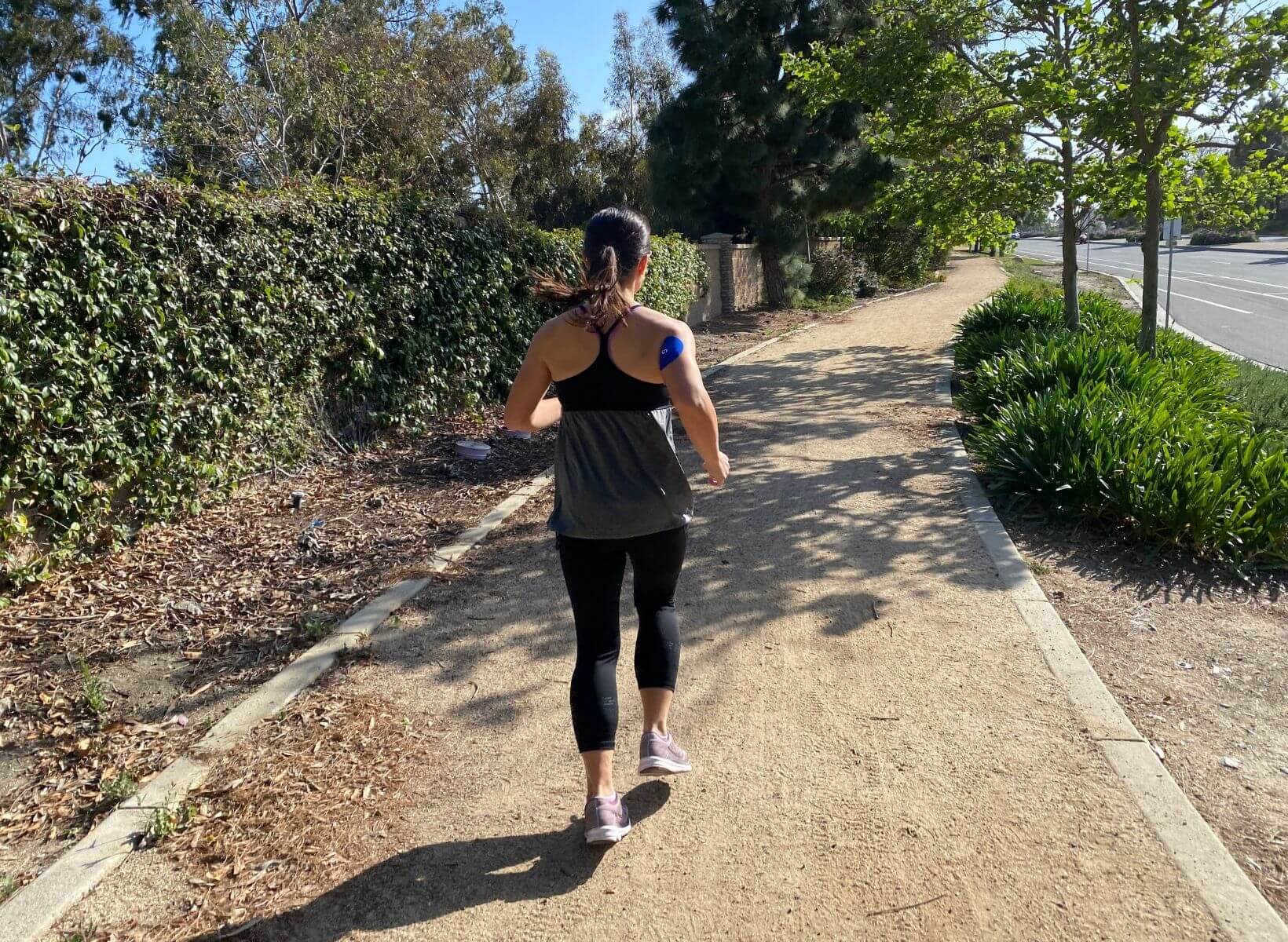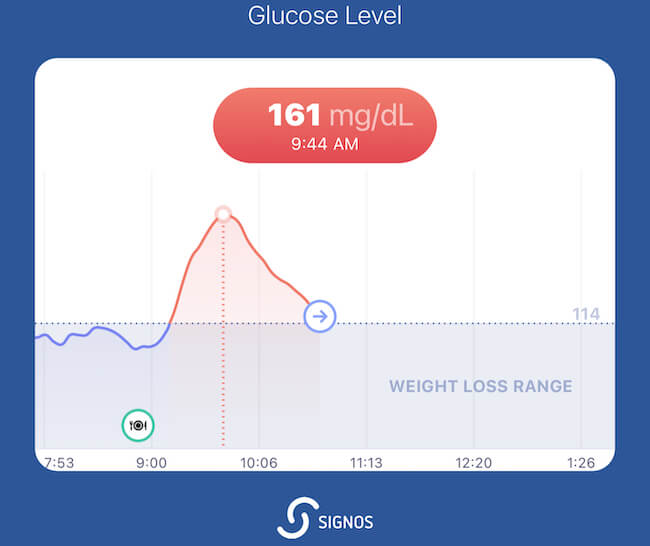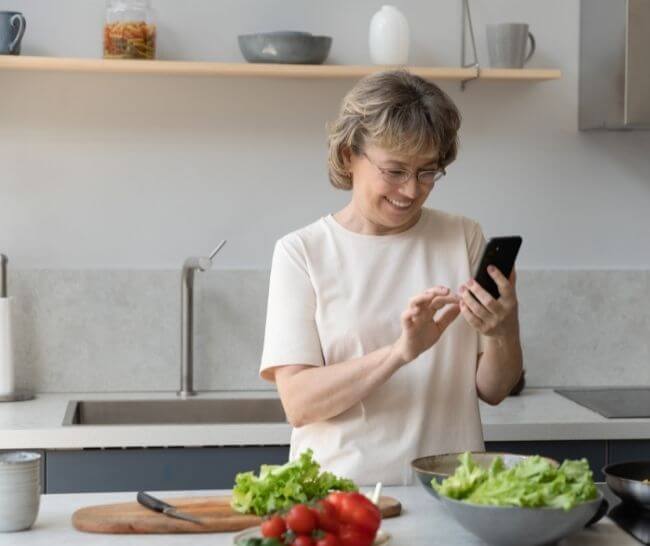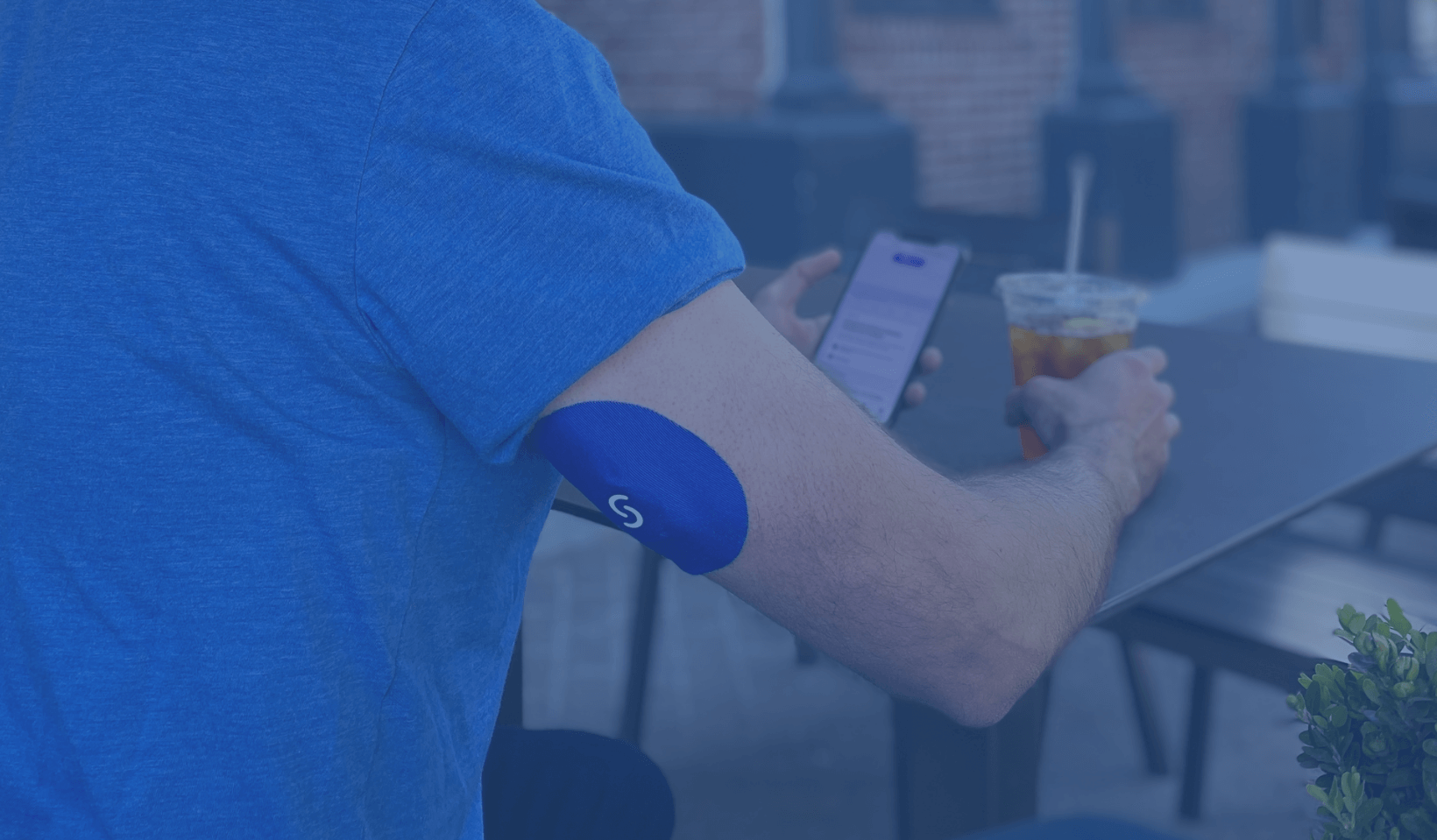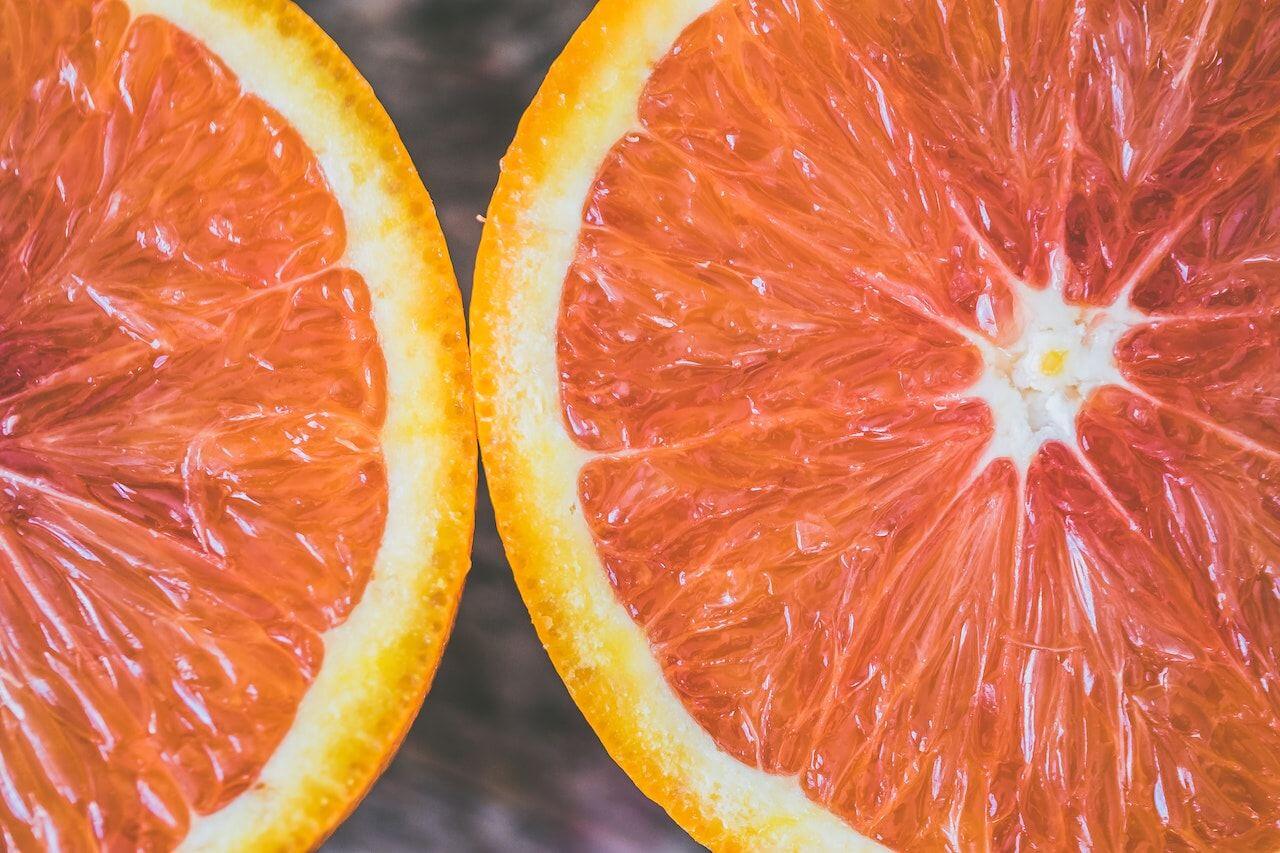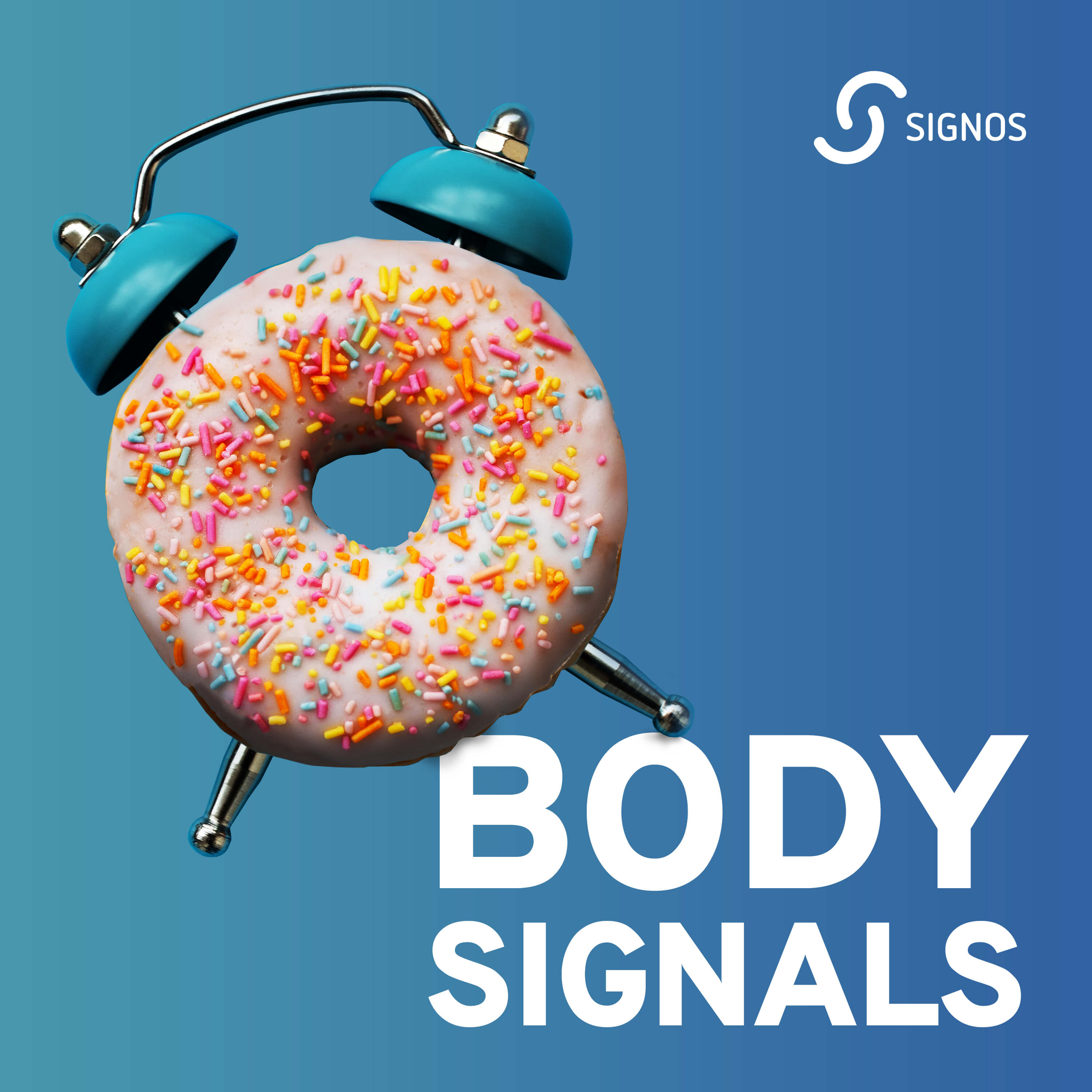Avoid glucose spikes as much as possible—that’s a core mantra of Signos. Excess glucose that doesn’t get used can be stored as fat. If you want to lose weight—or even maintain your existing weight—it’s beneficial to avoid glucose spikes or plan to burn that extra energy when they do happen.
What does this look like in real-life applications? Keep reading to discover how a few Signos employees mitigated an orange juice (aka liquid sugar) high glucose spike with exercise and pairing the orange juice with protein, fiber, and fat.
First: a quick primer on what happens to the body during a glucose spike.
Glucose, or sugar, gets released in your blood after eating and this causes your pancreas to release insulin. If you don’t use the energy soon, it gets stored for use later.
Eating or drinking foods that instigate high glucose spikes can make it more likely that any glucose you don’t use for energy now will get stored as glycogen in the muscles and liver or (worse for weight loss) in the tissues as fat.
<p class="pro-tip">Read these tips on how to control post-meal glucose spikes</p>
A finite amount of glycogen can be stored in the muscles and liver but an infinite amount can be hoarded into our adipose (aka fat) tissue. As anybody who’s tried to lose weight can tell you: burning through fat stores to get leaner takes hard work. To access stored fat for energy requires that you use up any glucose in your bloodstream first, followed by stored glycogen before you can access your fat stores.
3 Strategies for Burning Fat
Don’t abandon hope! Weight loss and improved body composition—less body fat and the ability to see some muscle—are achievable. The following strategies can help:
- Avoid high glucose spikes. Eat and drink in a way that prevents high glucose spikes. Strive for a whole food diet with little to no processed foods and limited treats made with added sugar and artificial sweeteners.
- Keep portions reasonable and matched to your activity amount. Even overeating real foods can cause glucose spikes—though unlikely to look the same as skyscraper-high glucose spikes that can happen from ingesting a bunch of sugar at one time. If you eat more than you need, insulin can and will tell that glucose to hibernate in your thighs.
- If you do spike, move it to lower it. Bring down a glucose spike with exercise. How hard and how long to exercise depends on the individual, but Signos generally recommends 10–15 minutes of movement at a moderate intensity to bring down a spike.
But, how can you apply these tips in real life? Experiment to find the foods or drinks that spike your glucose, and either avoid those things, or implement strategies—such as food combinations, meal timing, and exercise—to blunt the effects.
<p class="pro-tip"><strong>Learn about </strong> <a href="/blog/how-long-lower-blood-sugar-spike">how long it takes for a blood sugar spike to come down</a>.</p>
Can You Drink Sugar and Avoid a Glucose Spike?
Bill Tancer, Signos’ Bill-Nye-the-science-guy-type data scientist challenged the Signos staff to drink 8 ounces of orange juice, fasted, on Day 1 to see how it spiked glucose. On Day 2, staff was instructed to do whatever it took to lessen the glucose spike curve. The Signos staff employed creative approaches to lowering the high glucose spike on Day 2; keep reading to find out what they did.
Out-Running a Glucose Spike
Bill, Pierre (iOS engineer), and Sharam (CEO) successfully outran a high glucose spike:
- Bill’s Day 1 orange juice glucose spiked to 136; on Day 2, he completed intervals for 30 minutes on the treadmill and avoided raising his glucose above 92 mg/dL.
- Out-running a high glucose spike required Sharam to run two miles at an average heart rate of 161 soon after he drank the 8 ounces of orange juice.
- Pierre avoided a high spike by running just one mile with an average heart rate of 166; he went from a Day 1 high spike of 136 mg/dL to a Day 2 post-juice-and-run glucose of 66 mg/dL.
Does it matter how soon after drinking juice you need to start exercising to avoid a high glucose spike? Our experiments show that it does. Reed, our product designer, waited until after he received the high glucose spike notification in the Signos app to start exercising.
Sip Then Spin: Reed’s Ride to (Slightly) Lower Glucose
When Reed drank 8 ounces of orange juice on Day 1, his glucose spike reached 139 mg/dL, and while he spiked to 131 mg/dL on Day 2, he was able to lower his glucose back into his optimal weight loss range pretty quickly once he started a spin workout.
Reed rode his Peloton for 23 minutes total with an average heart rate of 139 to lower the orange juice spike. Could he have avoided the Day 2 high spike by starting his ride earlier? Evidence from the out-running-a-spike experiment supports this assumption.
Remember, orange juice is basically liquid sugar, particularly if it doesn’t contain pulp (note: we all drank orange juice without pulp in case the fiber slowed down the glucose response). It enters the bloodstream faster than food, particularly when ingested by itself.
Kettlebell and Smoothie: An Average Day for Jake
Jake, Android engineer and dominant champion of nearly every Signos staff challenge and experiment, outsmarted an out-of-weight-loss-range glucose spike by exercising before he drank orange juice on days 1 and 2. He finished 500 kettlebell swings with a 24kg (53-pound) kettlebell then waited for his glucose to stabilize before drinking any orange juice.
Jake’s glucose after he worked out, waited, then drank 8 ounces of orange juice on Day 1. His glucose peaked at 106 mg/dL.
Jake’s glucose after he worked out, waited, then drank 8 ounces of an orange juice smoothie on Day 2. His glucose peaked at 76 mg/dL.
Jake’s High-Protein Orange Smoothie Recipe
Ingredients
- 1 bottle Naked Juice Power C Machine
- 2 scoops Vital Proteins Collagen Peptides
- 1 scoop Myprotein Impact Whey Protein (Unflavored)
- ¾ cup Fage 2% Greek Yogurt Plain
- 1 cup Silk Ultra Milk
- 1 Tbsp. Bulletproof Upgraded MCT Oil
Instructions
Blend all ingredients in a blender until smooth.
Jake’s smoothie contained 59.5 grams of protein, 18.2 grams of fat, and 35 grams of carbs. You can see how the protein and fat helped control his glucose response—no spike!
The Workout Smoothie Sandwich: Spikey Sabrina’s Approach
Woof. Orange juice isn’t my idea of a cheat treat. My sugary food fantasies fixate on gooey-in-the-center, still-warm cookies; extra creamy pistachio or salted caramel ice cream; or flaky croissants filled with marzipan that leave traces of European-style butter on my fingertips. But I’m a team player so it was game on!
My peak spike on Day 1, after drinking 8 ounces of orange juice in a fasted, pre-exercise state, which peaked at 213 mg/dL, then dipped to about 65 mg/dL before leveling out at 84 mg/dL.
Note my new self-appointed work nickname: Spikey Sabrina.
To mitigate the Mt. Everest-high glucose spike after drinking another 8 ounces of orange juice on Day 1, I did three things on Day 2:
- Endured a glucose-spiking effort on a fasted run. After a 2-mile warm-up of super-easy jogging, I did 10x30-second hill sprints, then finished with about a 2-mile cooldown. I ran 6 miles total.
- Combined the 8 ounces of orange juice with other foods to make a smoothie. I added some protein, fat, and fiber to the smoothie in the hopes that it would help slow down, and maybe even prevent, a glucose spike. I drank the smoothie within 20 minutes of finishing the run. See the recipe below.
- Followed the smoothie with a 30-minute circuit workout. I followed a workout designed by my favorite Youtube trainer, Sydney Cummings.
Disclaimer: This is what worked for me. It’s not medical or training advice. If you’re not an experienced runner or very fit, please don’t try to copy exactly what I did; I wouldn’t want you to get injured.
{{mid-cta}}
Orange Kale Chia Smoothie Recipe
Ingredients
- 8 oz. orange juice
- 3 cups kale
- 1 scoop Primal Kitchen Primal Fuel - Vanilla Coconut*
- 1 Tbsp. chia seeds
- ½ cup 2% fat plain Greek yogurt
Instructions
Toss all ingredients into a high-speed blender and blitz until smooth. Add ice if you want it cold.
Orange Kale Chia Smoothie macros: 29% protein, 56% carbs, 15% fat and 542 calories.
The result of this effort measured 60 minutes after drinking the orange juice smoothie: my glucose peaked at 93 mg/dL.
Did I need to sandwich the smoothie between two workouts to avoid spiking out of my weight loss range? It’s unclear, but I didn’t want to take any chances.
The Great Orange Juice Experiment Takeaways
Can you slow down or even prevent a glucose spike? According to our Signos staff experiment, you can. Here’s how we did it:
- Exercise before drinking juice. If you exercised at a high or relatively high intensity, wait for your glucose to stabilize before drinking the juice.
- Exercise after drinking juice. Our experiments suggest exercising immediately after downing the juice can help avoid a spike. Intensity and duration of exercise varied some, but the general rule: Get your heart rate up to a moderate to a moderately high level for at least 10 minutes.
- Combine juice with protein, fat, and/or fiber to slow down and possibly lower the glucose response. The two staff smoothie recipes above show you how.
More Signos Articles About Glucose & Blood Sugar
Glucose & Blood Sugar FAQs
- What Is Glucose?
- What Is Glycemic Index and Glycemic Load?
- How Does A CGM Work?
- Why Should You Track Your Glucose?
- How to Mitigate High Glucose Spikes to Avoid Fat Storage
- What Is Impaired Fasting Glucose and Why Does it Matter for Your Health?
- Why Is Your Blood Sugar Higher in the Morning?
- What Should Your Blood Sugar Be at Bedtime?
- Can You Lower Blood Sugar by Drinking Water?
- Can Stress Cause High Blood Sugar?
Lowering & Stabilizing Your Blood Sugar
- How to Exercise to Lower Blood Sugar Quickly
- How To Naturally Lower Blood Sugar Fast
- Everyday Foods That Stabilize Blood Sugar Levels
- Stable Blood Sugar: How To Reap and Keep the Benefits
- The Relationship Between Alcohol and Your Blood Sugar
Low-Glycemic Diet
- Low Glycemic Diet & Tips for Managing Blood Sugar
- 7-Day Low Glycemic Diet Plan
- 5 Low-Glycemic Dinner Recipes for Busy Weeknights
- Easy Low-Glycemic Lunch Ideas From an RDN
- Low-Glycemic Snacks for Healthy Eating Between Meals
- Low-Glycemic Recipes for Summer
- Low Glycemic Recipes for Fall
- Item 1
- Item 2
- item 3

